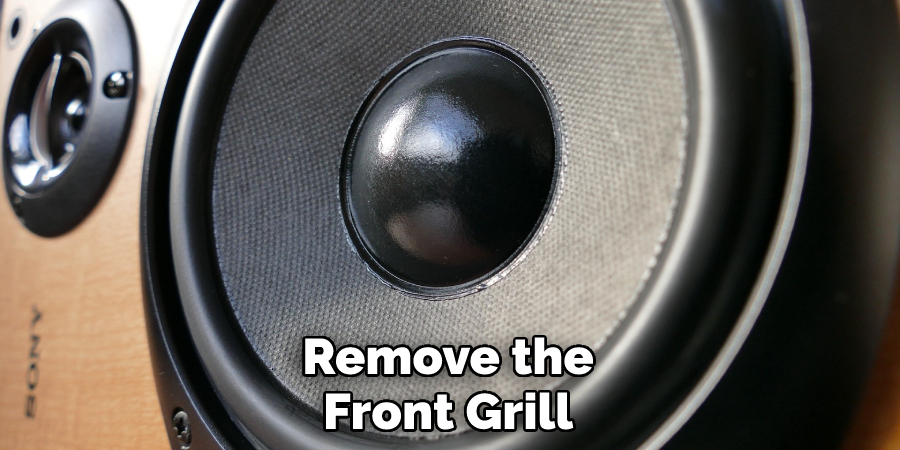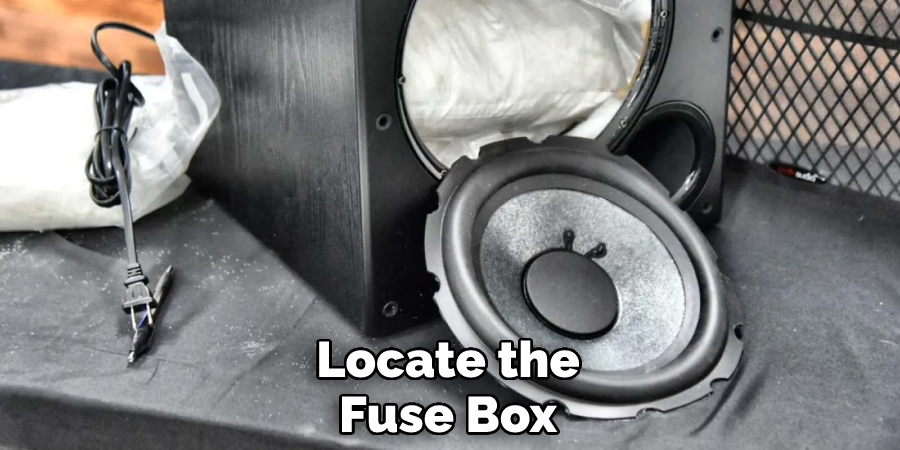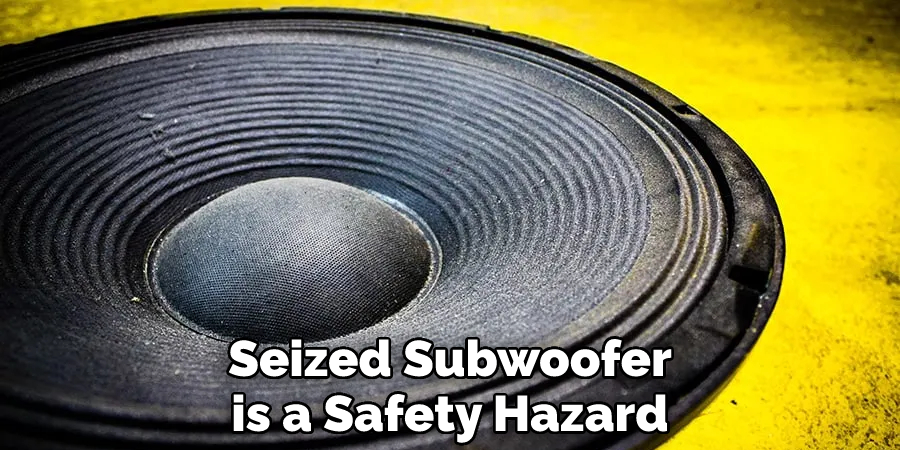Subwoofers can boost your car audio system by providing loud and clear bass. However, if your subwoofer is seized, it can be challenging to get it working properly again. This post will outline how to fix a seized subwoofer. We will also provide tips on preventing your subwoofer from seizing in the future. Keep reading to learn more!

Summary: There are several things you can do to fix the issue. First, try lubricating the moving parts and cleaning the subwoofer. Next, cool the subwoofer and use a different power source. Then, replace any faulty fuses or capacitors as well as adjust the settings. If all else fails, check for manufacturing defects or hire a professional. Ultimately, you may need to replace the subwoofer if all else fails.
What Causes a Subwoofer to Seize?
There are several reasons why your subwoofer may have seized. The most common cause is a loss of lubrication. Over time, the lubricant in your subwoofer can break down and become insufficient. This can cause the moving parts in your subwoofer to rub against each other, which can lead to seizing. Another common cause of seizing is dirt and debris build-up. If your subwoofer is not regularly cleaned, dirt and debris can accumulate in the moving parts. This can cause the parts to stick together and eventually seize.
Additionally, subwoofers can seize if they are overheated. If your subwoofer gets too hot, the moving parts can expand and become stuck. The other causes of seizing are less common but can still occur. These include manufacturing defects, damage from an external force, and water damage. Lastly, subwoofers can also seize if they are not used for an extended period. This is because the moving parts can rust and become stuck together.
Why Is It Important to Fix a Seized Subwoofer?
It is important to fix a seized subwoofer for several reasons. First, a seized subwoofer will not be able to produce sound. This can be frustrating if you are trying to listen to music or watch a movie with your car audio system. Additionally, a seized subwoofer can damage your car’s audio system. If the subwoofer is rubbing against other parts of the system, it can cause those parts to break.
This can be expensive to fix and may require you to replace your entire car audio system. Finally, a seized subwoofer can be dangerous. If the subwoofer is located near the gas pedal, it can cause your car to accelerate unexpectedly. This can be dangerous for you and other drivers on the road.

Some Effective Ways How to Fix a Seized Subwoofer
1. Lubricate the Moving Parts
The first step to fixing a seized subwoofer is lubricating the moving parts. This will help to prevent the parts from rubbing against each other and eventually seizing. You can use a variety of lubricants, but we recommend using a silicone-based lubricant. This type of lubricant will not break down over time and will provide long-lasting protection for your subwoofer.
To apply the lubricant, first, remove the subwoofer from your car. Next, locate the moving parts and apply a generous amount of lubricant. Finally, re-install the subwoofer and test it to see if it works properly. If the subwoofer is still seized, move on to the next step.
2. Clean the Subwoofer
If your subwoofer is seized due to dirt and debris build-up, you must clean it. First, disconnect the subwoofer from its power source. Next, remove the front grille (if applicable) and unscrew the driver. With the driver removed, you should be able to see the inside of the subwoofer. Use a can of compressed air to blow out any dirt and debris. If the build-up is excessive, you may need to use a cotton swab or toothbrush to remove it. Try not to get any water inside the subwoofer. Once you have cleaned the subwoofer, reassemble it and reconnect it to its power source.

3. Cool the Subwoofer
If your subwoofer has seized due to overheating, you will need to cool it down. This is because continued use of a subwoofer that is overheating can cause irreversible damage. The best way to cool down your subwoofer is to remove it from the power source and allow it to sit. Once the subwoofer has cooled down, you can then troubleshoot the issue and take steps to prevent the issue from occurring again.
4. Use a Different Power Source
If your subwoofer has seized due to a power surge, you will need to use a different power source. The surge’s current may have damaged your subwoofer’s internal components. First, unplug your subwoofer from the wall outlet to use a different power source. Then, plug it into a different outlet. You can use a power strip if you do not have another outlet available. However, make sure that the power strip is surge-protected.
5. Replace the Fuses
If your subwoofer has seized due to a blown a fuse, you will need to replace the fuse. To do this, first, locate the fuse box. This is usually located near the subwoofer’s power supply. Once you have found the fuse box, please open it and locate the blown a fuse. Once you have found the blown a fuse, replace it with a new one of the same amperage. Be sure to check the fuse box for any other damaged fuses and replace them as well.

6. Replace the Capacitor
If your subwoofer has seized due to a damaged capacitor, you will need to replace it. To do this, first, locate the capacitor. It will be a small, cylindrical device with two wires coming out of it. Once you have found the capacitor, use a screwdriver to remove the two screws that hold it in place. Then, carefully remove the old capacitor and install the new one in its place. Finally, screw the new capacitor in place and reconnect the wires.
7. Adjust the Settings
You will need to adjust the settings if your subwoofer has seized due to an incorrect setting. First, locate the subwoofer’s power cord and unplug it from the outlet. Next, find the volume knob on the subwoofer and turn it to the left as far as it will go. Then, locate the crossover knob and turn it to the right as far as it will go. Finally, plug the power cord back into the outlet and turn on the subwoofer.
8. Check for Manufacturing Defects
You will need to check for manufacturing defects if your subwoofer has seized due to a defect. The best way to do this is to contact the manufacturer and ask about their warranty policy. If they do not have a warranty, you may be able to get a refund or replacement. If the manufacturer does have a warranty, they will likely send you a replacement subwoofer. Make sure to follow their instructions carefully so that you do not void the warranty.
9. Hire a Professional
If your subwoofer has seized and you cannot fix it, you may need to hire a professional. A professional can troubleshoot the issue and determine if it can be fixed. They may also be able to prevent the issue from occurring again. Make sure to ask about their rates and services before hiring them.
10. Replace the Subwoofer
If your subwoofer has seized and you cannot fix it, you may need to replace it. This is because a seized subwoofer is a safety hazard and can cause damage to your car. You will need to purchase a new subwoofer and install it according to the manufacturer’s instructions. Always follow all the instructions carefully so you do not void the warranty.

Tips and Warnings on How to Fix a Seized Subwoofer
Tips
- Be sure to have the correct tools. You will need a flathead screwdriver, a pair of pliers, and a hammer.
- Begin by gently prying up the edge of the subwoofer with the flathead screwdriver.
- Once you have pried up the edge, use the pliers to grip the subwoofer and pull it up.
- If the subwoofer is still stuck, use the hammer to tap on the side of the subwoofer until it comes loose.
Warnings
- Do not use too much force when prying up the edge of the subwoofer, as this could damage it.
- Be careful not to drop the subwoofer when removing it from the speaker.
- Make sure that the subwoofer is not plugged in before beginning this repair.
- Do not attempt to repair a subwoofer if you are not confident in your ability to do so. Always consult with a professional if you are unsure.
How Much Does It Cost to Fix a Seized Subwoofer?
The cost of fixing a seized subwoofer will vary depending on the cause of the seizure. For example, if the subwoofer has seized due to a blown a fuse, you will only need to replace the fuse. This should cost less than $10. If the subwoofer has seized due to a damaged capacitor, you will need to replace the capacitor. This should cost between $20 and $30. If you hire a professional to fix the subwoofer, you can expect to pay between $50 and $100. Finally, if you need to replace the entire subwoofer, you can expect to pay between $100 and $200.
Frequently Asked Questions
What Causes A Subwoofer To Seize?
A subwoofer may seize for a number of different reasons, including overheating, dust accumulation and build-up on the motor or gears inside the unit, incorrect level of impedance in your system, and damage to the amplifier.
If you notice that your subwoofer is not producing adequate bass anymore or seems to be struggling to reproduce low-frequency sounds properly, it’s best to take it to a qualified technician for assessment. This will help determine if there is an issue with the woofer itself or with your entire audio system. If necessary, adjustments can then be made so that sound quality remains consistent throughout all frequencies.
Ultimately, keeping your audio equipment in good condition through regular cleaning and maintenance can help avoid issues like seizure occurrence.
Is It Worth Repairing A Subwoofer?
There are pros and cons to repairing a subwoofer, so it is important to weigh the benefits of doing so against the costs. The most common reason for needing to repair or replace a subwoofer is due to damage caused by excessive use. This can include scratches, dents, and broken parts that need to be replaced.
The good news is that most subwoofers are relatively easy and inexpensive to fix – you just need basic tools like a Phillips screwdriver and some adhesive tape.
Once you have removed the damaged part(s), you will need to dry them off completely before applying adhesive tape in specific areas where two pieces of metal meet (to minimize sound distortion). Repeat this process until all missing or broken parts have been replaced.
While repairing a sub-component might not always be cost-effective in comparison with buying a new one, it can still save you money down the road if your original investment was based on estimates rather than reality.
Why Did My Subs Stop Hitting Hard?
There could be a number of reasons your subwoofer may not be hitting hard – here are some of the most common:
- The amplifier may not be working properly. Test the amplifier by turning it off and on several times – if the power indicator stays steady, then the amplifier is probably not the issue. If you’re unsure whether or not your amplifier is working, you can try using an external speaker to see if the bass sounds better that way.
- The speakers may not be in good condition. Make sure that they’re properly secured to the wall and that there are no cracks or damaged areas. Check for loose wires or damaged ports on the speakers themselves.
- The crossover may be incorrectly set. To check this, turn off all other speakers in your room, turn on your subwoofer, and listen for how well it sounds when it’s playing alone. If it sounds muddy or indistinct, then the crossover may need to be adjusted.
- The volume level on your subwoofer may need to be increased. Check to make sure that the knob is turned all the way up and that all cables are properly plugged in. If these steps don’t seem to help, you can try replacing the speaker itself.
Will A Blown Sub Still Make Noise?
Technically, yes. A blown subwoofer will still make noise because of the vibrations that are propagation through the speaker and enclosure. However, it is likely to be significantly less loud than a working subwoofer due to the build-up of distortion and debris.
In some cases, this may not even be noticeable unless you are specifically trying to listen for it. If you do notice any abnormal sounds coming from your speakers or subwoofers, then there may be a problem that needs to be addressed as soon as possible.
Conclusion
So there you have it! Everything you need to know about how to fix a seized subwoofer. Follow the tips and warnings carefully so you do not damage the subwoofer. If you are unsure about anything, always consult with a professional. With these tips, you should be able to fix your seized subwoofer in no time!
